Save for smoothbore shotguns, all modern firearms have rifled barrels. There are exceptions such as riot guns and the Steyr IWS 2000 anti-tank rifle, but you typically won’t find these items for sale at the corner gun store. In this article, we explore how that rifling – called twist rate – impacts your shooting. We even include a 5.56 twist rate chart that’ll help you determine the likely best ammo to use with your AR-15.
A rifled barrel works simply enough: Spiraling grooves and lands on the bore force the bullet to rotate as it passes through the barrel. The bullet continues rotating once it has exited the muzzle, which grants it the gyroscopic stability it needs to follow a flat and predictable trajectory.
Without a rifled barrel, a firearm becomes terribly inaccurate. That’s why opposing armies had to stand so close to each other not so long ago. “Don’t fire till you see the whites of their eyes!” was sound advice during the Revolutionary War, when American patriots had smoothbore muskets and limited access to musket balls.
We have to provide the obligatory football analogy at this point. Picture your favorite quarterback throwing a pass. What does he do to the ball so it goes straight to the receiver? He puts the perfect amount of spin on it – just like what a rifled barrel should do to the bullet. God bless a country where you can explain practically anything to people using football analogies!
5.56 Twist Rate Chart
| Bullet Weight (gr) | 40 | 45 | 50 | 55 | 60 | 62 | 65 | 69 | 70 | 75 | 77 | 80 | 85 | 90 |
|---|---|---|---|---|---|---|---|---|---|---|---|---|---|---|
| 1:6" | __________ | __________ | __________ | __________ | __________ | __________ | __________ | __________ | __________ | __________ | __________ | __________ | __________ | __________ |
| 1:7" | __________ | __________ | __________ | __________ | __________ | __________ | __________ | __________ | __________ | __________ | __________ | __________ | __________ | __________ |
| 1:8" | __________ | __________ | __________ | __________ | __________ | __________ | __________ | __________ | __________ | __________ | __________ | __________ | __________ | __________ |
| 1:9" | __________ | __________ | __________ | __________ | __________ | __________ | __________ | __________ | __________ | __________ | __________ | __________ | __________ | __________ |
| 1:10" | __________ | __________ | __________ | __________ | __________ | __________ | __________ | __________ | __________ | __________ | __________ | __________ | __________ | __________ |
| 1:12" | __________ | __________ | __________ | __________ | __________ | __________ | __________ | __________ | __________ | __________ | __________ | __________ | __________ | __________ |
| 1:14" | __________ | __________ | __________ | __________ | __________ | __________ | __________ | __________ | __________ | __________ | __________ | __________ | __________ | __________ |
| 1:16" | __________ | __________ | __________ | __________ | __________ | __________ | __________ | __________ | __________ | __________ | __________ | __________ | __________ | __________ |
Stick to the green and your shooting should be clean.
What Is a Barrel’s Twist Rate?
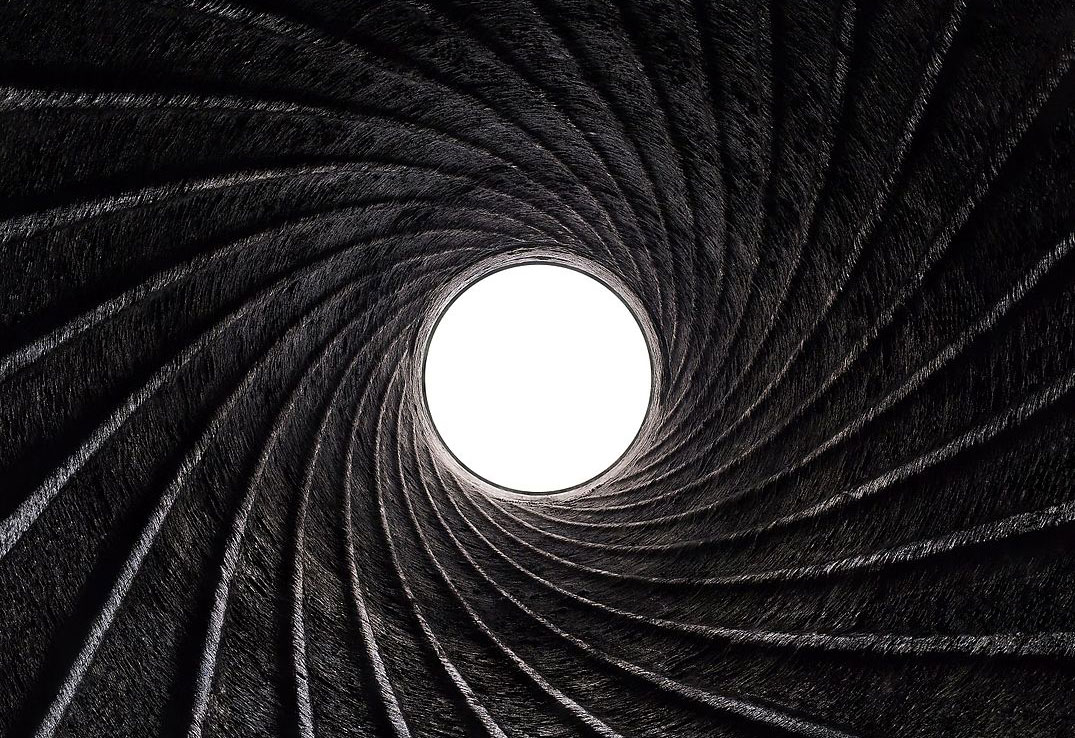
The rifling of an M75 cannon – an exaggerated, but similar, function that’s likely inside your rifle.
To recap, rifling makes a firearm far more accurate by putting spin on the bullet before it rips out of the muzzle. But not all rifling is the same!
A barrel’s “twist rate” or “rate of twist” describes its rifling. This concept is expressed as a ratio. A barrel with a twist rate of 1:10”, for example, means that the bullet will make one complete rotation for every 10” of that barrel it passes through. A 16” barrel with a 1:10” twist rate will therefore rotate a bullet 1.6 times before it clears the muzzle.
Counterintuitively, what we would call a “low” rate of twist will actually spin the bullet faster. For example, a 1:6” rate of twist is lower than a 1:12” rate of twist, even though the bullet passing through the 1:6” barrel will rotate at double the rate of the 1:12” barrel.
What Is the Best Rate of Twist for a 5.56×45/.223 AR-15?
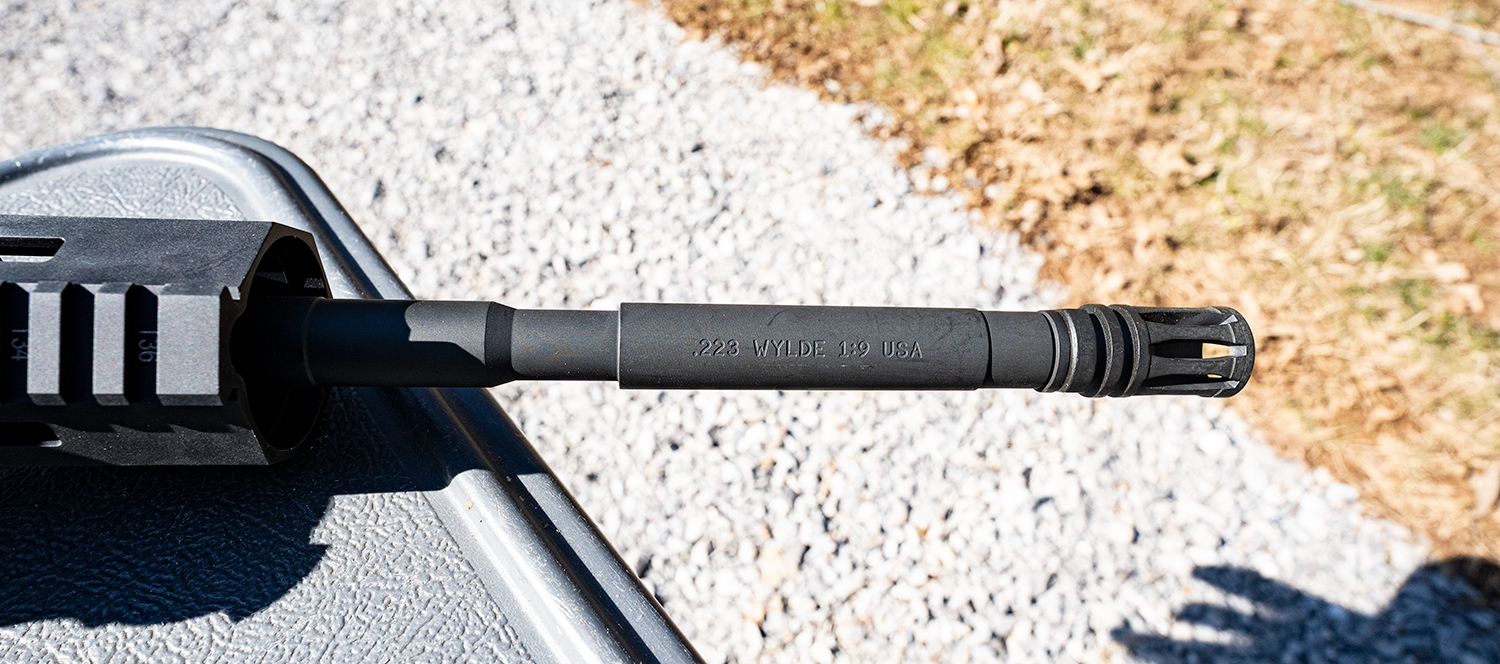
The 1:9 twist rate of our 223 Wylde barrel clearly displayed.
The ideal rate of twist varies depending not only on which type of cartridge you are firing, but also that cartridge’s bullet weight. Why is this? Because heavier bullets have more inertia than lighter ones; more energy is required to move them. In the case of 5.56×45 ammo, a heavyweight 77 grain bullet thus requires a much lower rate of twist than a featherweight 45 grain projectile.
Before we proceed any further, take a look above at our expertly prepared AR-15 barrel twist rate chart. Green represents an ideal rate of twist; yellow indicates a less than ideal rate of twist; red indicates a poor rate of twist. (There is no safety hazard associated with red – unless you’re firing in self-defense and cannot hit your target, that is.)
Other Twist Rate Considerations
Is the chart in this article definitive? Not remotely. It only serves to give you a rough idea of which rates of twist are best for an AR-15 depending on which ammunition you’re firing.
For example, a 1:7” rate of twist is arguably more lower than what is needed to stabilize a 55 grain projectile. But our military’s M4 carbine comes stock with a 1:7” twist barrel, and the standard M193 5.56 cartridge has a 55 grain bullet. Did the government do that to purposefully play a prank on our soldiers?
Not at all. In general, a lower rate of twist than what is necessary doesn’t greatly harm accuracy. Many people believe that too low a rate of twist will “over rotate” or “over stabilize” the bullet, which in turn may cause it to burst apart midair under its own centrifugal force, just like a poorly sculpted bowl would unravel on top of a potter’s wheel.
But bullets are pretty hardy, so there’s a fairly low chance of this happening. An important exception to this is frangible bullets. These are made of compressed copper and tin powder and brittle by design. We don’t recommend a fast twist rate (avoid something like 1:7) if you wish to avoid watching your frangible bullets rip themselves apart in midair.
What About Larger Bullets?
Heavier bullets do demand an appropriate rate of twist if they’re going to demonstrate their best accuracy. If a bullet receives inadequate rotational stability, it’s going to begin wobbling at medium-to-long range. This isn’t a huge problem if you’re just plinking, but if you’ve invested in some match grade 77gr OTM 5.56 ammo, you’d really do best to also invest in a suitable barrel so you can witness your ammo’s true potential in person.
Finally, we must point out that no AR-15 barrel twist rate chart is definitive. Several other factors come into play with an AR-15 including its barrel length, the quality of its barrel, and its barrel’s exact diameter. Lower quality ammunition may not have very consistent bullet diameters, and atmospheric conditions like air temperature and humidity always have subtle impacts on ballistic performance.
In summary, consulting a chart is a good way to get on the right track when it comes to selecting the best barrel twist for your AR-15, but nothing substitutes for actual hands-on testing. Don’t be afraid to buy a new barrel with a different rate of twist for your rifle! It’s not all that expensive, and easily swapping out parts is one of the greatest advantages an AR-15 offers. Also don’t be afraid to try out lots of different types of ammo and bullet weights – there are a ton of variables at play. (Just make sure you order all that 5.56 ammo from us, haha!)

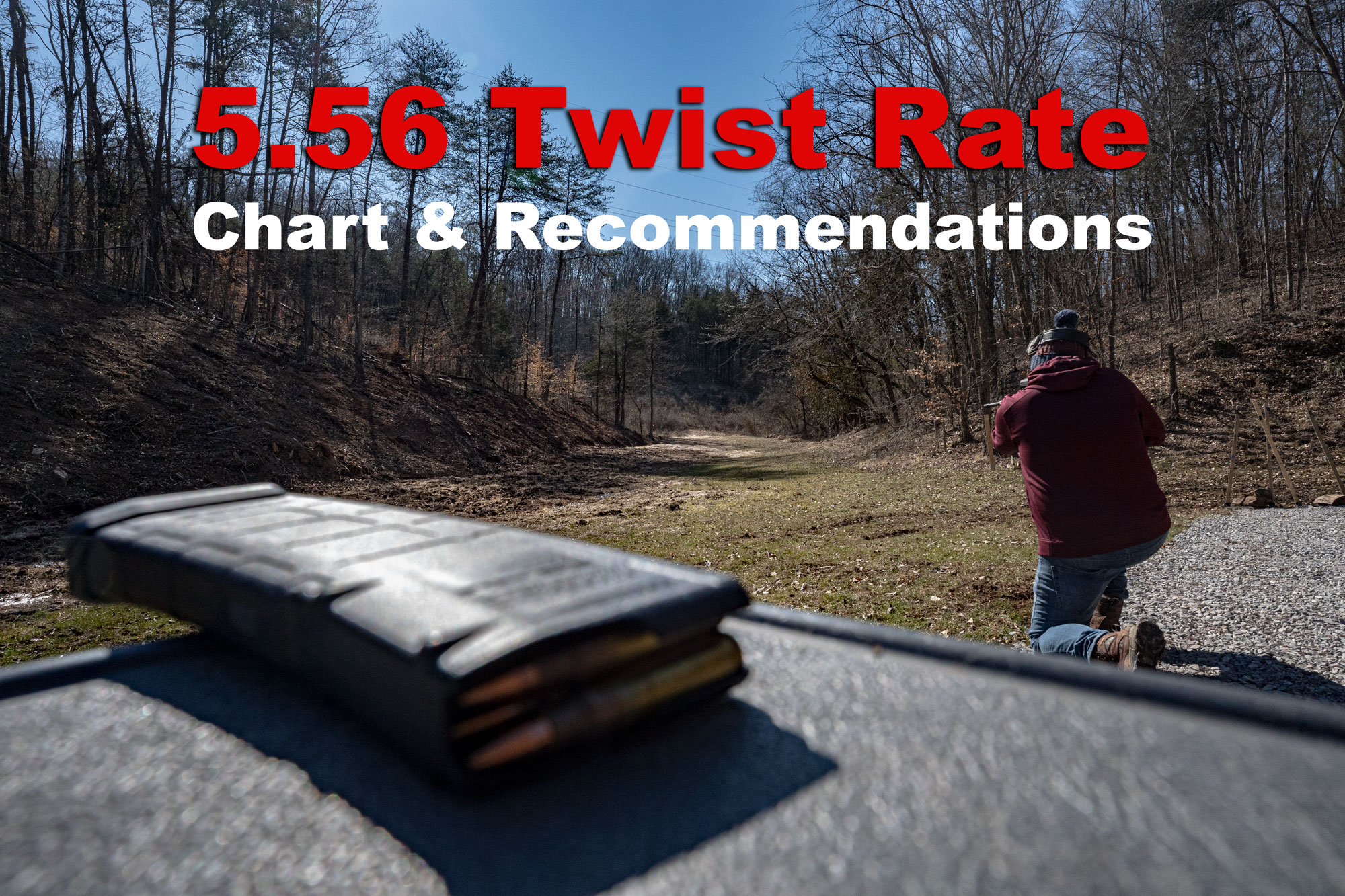
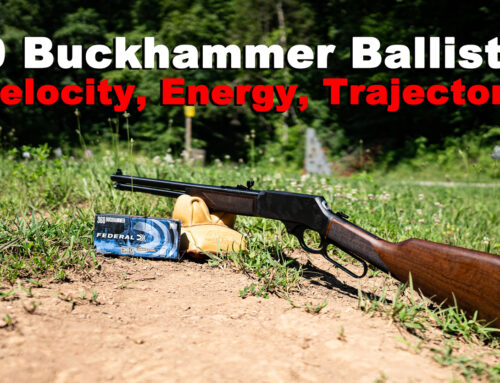
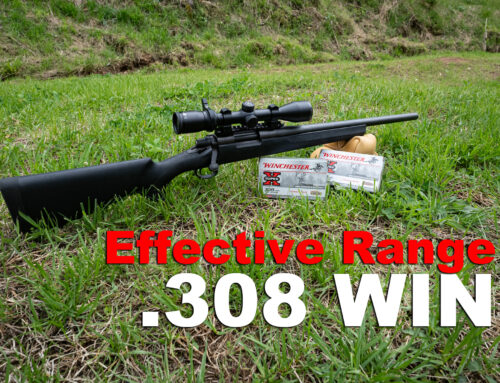
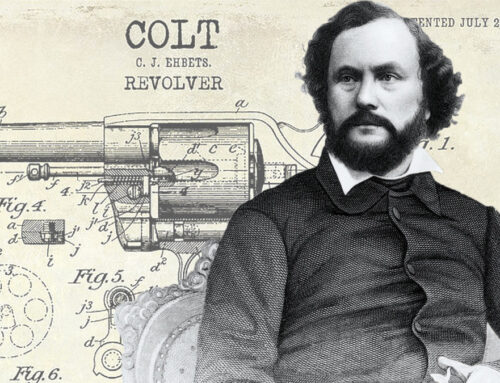
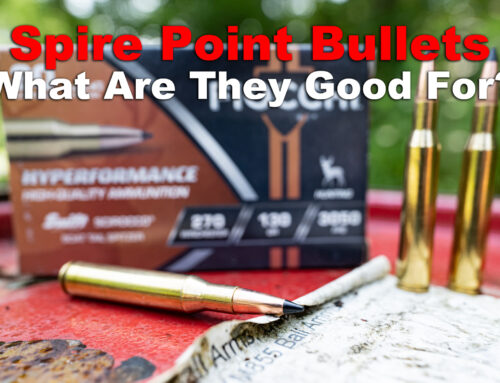
I was looking up twist rate info. on your website. This paragraph sounds contradictory. Please explain.
“But bullets are pretty hardy, so there’s a fairly low chance of this happening. An important exception to this is frangible bullets. These are made of compressed copper and tin powder and brittle by design. A faster rate of twist is indeed advisable if you wish to avoid watching your frangible bullets rip themselves apart in midair.”
Thankyou,
Steve Inlow
Hi Steve, thanks for the heads up. You are correct – that is contradictory and typically we would not advise faster twist rates for use with frangible bullets. We’ve updated the article to make that clearer and thank you for the heads up!
Hi, I have a 14.5 inch barrel on a Daniel Defense M4 A1 with a 1:7 twist rate wich 5.56 bullet weight would be the most consistently accurate? I’m looking to stock pile. Thank you so much for your time
Hi BigTexis – you should be good to go with just about anything 55 grain and can get away with heavier bullets too. For some more anecdotal evidence, this thread on AR-15.com is a good one about guys with 14.5″ barrels and what they’re using: https://www.ar15.com/forums/ar-15/Question_for_owners_with_14_5andamp_quot__barrels_and_1_7_twist_rifling/118-667760/.
Appreciated.
Have had the experience of frangible bullets coming undone a few feet out of the muzzle when fired in a fast twist barrel. These bullets are designed to perform at high velocity (explosive) but can’t survive the faster centrifugal spin.. They do well in the 1:12,
1:14 twists however.